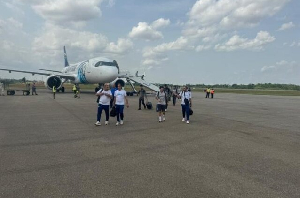- Home - News
- TWI News | TV
- Polls
- Year In Review
- News Archive
- Crime & Punishment
- Politics
- Regional
- Editorial
- Health
- Ghanaians Abroad
- Tabloid
- Africa
- Religion
- Election 2020
- Coronavirus
- News Videos | TV
- Photo Archives
- News Headlines
- Press Release
Business News of Monday, 26 August 2013
Source: B&FT
MOFEP, GRA finalise modalities for airport tax
The Ministry of Finance and Economic Planning (MOFEP) and the Ghana Revenue Authority (GRA) are finalising modalities for the eventual disbursement of airport taxes collected between March and August 2013 to the Ghana Airport Company Limited (GACL) by the end of September.
“They are still working on the modalities; we are far advanced in the process. Maybe by next month they will have completed [the modalities],” Mr. Twumasi Ankrah Selby, Chief Director of the Ministry of Transport, told the B&FT in an interview.
The 2013 budget presented by the Minister of Finance and Economic Planning, Mr. Seth Terkper, and approved by Parliament in March, approved the retention of monies realised in airport taxes by the GACL to enable the company to undertake maintenance and expansion works on the various airport infrastructure in the country.
Under the past arrangement, which had been in place since 2001, 60 percent of all airport taxes go directly to the Ghana Revenue Authority to support the national budget while 40 percent is left for the supervising entity, the GACL.
About GH¢51million of what was realised in airport taxes in 2012 was used to support the national budget. While about GH¢37million and GH¢47million was paid to the GRA in 2010 and 2011 respectively.
“The GACL will now be able to undertake the development and maintenance of airport facilities in the country. Because of limited funds, the regional airports like Kumasi are in their current state. It [GACL] will now have enough money to maintain, upgrade, and do periodic maintenance,” Mr. Selby told the B&FT in an earlier interview.
The International Civil Aviation Organisation’s (ICAO) regulations postulate that “airports may produce sufficient revenues to exceed all direct and indirect operating costs (including general administration, etc.); and so provide for a reasonable return on assets at a sufficient level to secure financing on favourable terms in capital markets for the purpose of investing in new or expanded airport infrastructure and, where relevant, to remunerate adequately holders of airport equity.”
The Government’s priority projects include expansion of the current facilities at Kotoka International Airport (KIA), and the expansion and eventual conversion of the Tamale and Kumasi domestic airports into international airports to service the middle and northern belts. This requires intensive capital investment from the GACL and its partners to achieve. It also makes it imperative for the airports’ manager to retain the revenue it generates for such endeavours.
The increase in flight frequencies of 36 scheduled airlines servicing the Kotoka International Airport (KIA) and an increase in international passenger throughput to 1.7 millon and a domestic passenger throughput of 540,000 respectively in 2012, have necessitated renovation of the only international airport in the country.
While passengers have complained about poor facilities within the country’s airports, domestic operators have blamed the non-availability of runway lights at the Kumasi and Tamale domestic airports for their inability to operate late-night flights to those cities.











